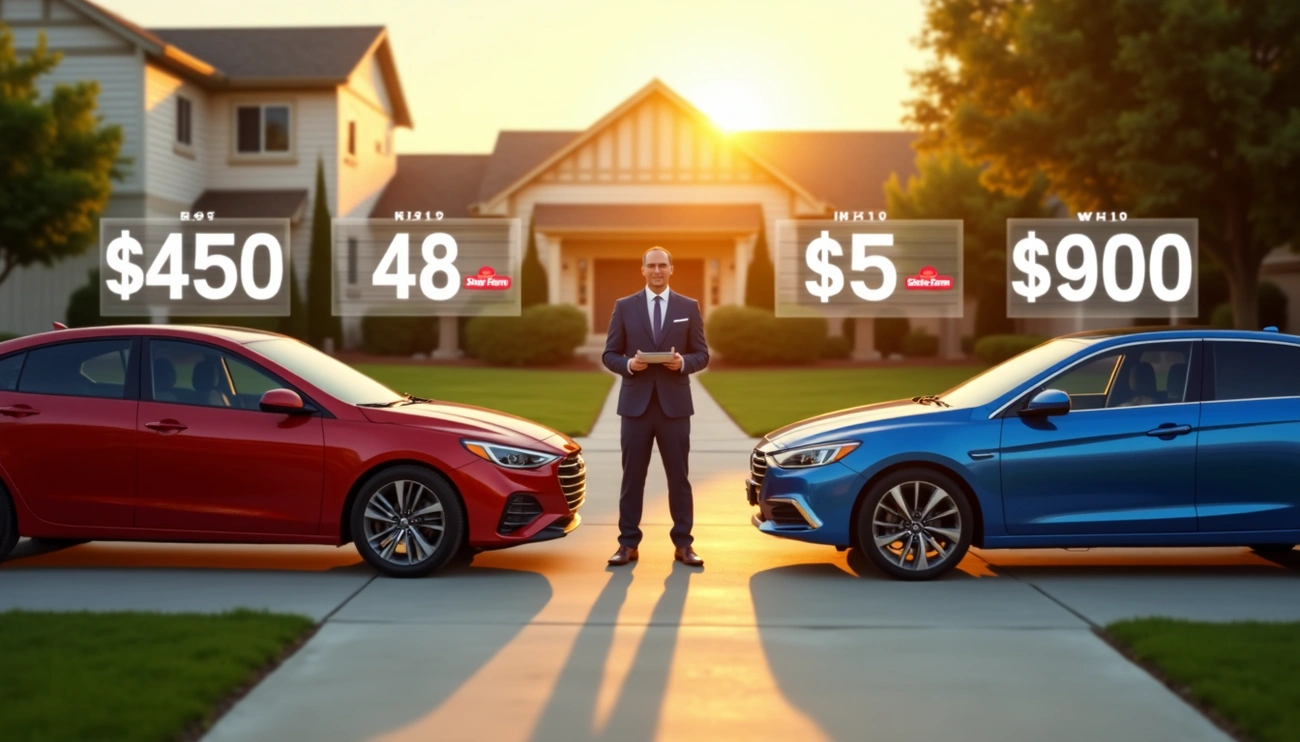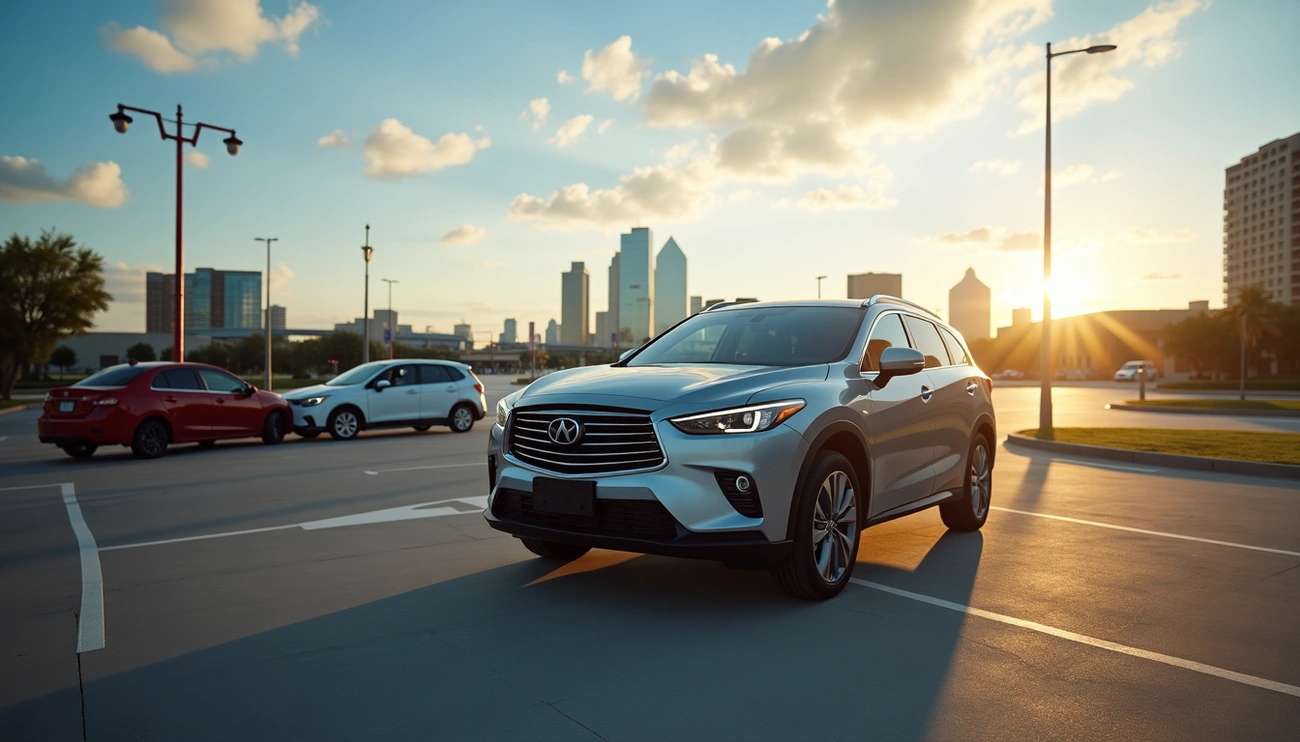Comparing State Farm vs Geico reveals surprising price differences that could save you thousands on your insurance premiums. As the largest and third-largest property and casualty insurers in the U.S. respectively, these insurance giants offer dramatically different rates depending on your driver profile. While Geico’s average annual full-coverage rate sits at $1,939, State Farm comes in higher at $2,721. However, when it comes to specific situations, the numbers tell a different story. For instance, State Farm charges drivers with an at-fault accident $1,843 annually compared to Geico’s steep $3,341 – making State Farm 81% cheaper in this category. Although Geico generally offers lower premiums, especially for drivers with poor credit ($3,093 vs State Farm’s $5,654), State Farm edges ahead in customer satisfaction with a J.D. Power score of 833 compared to Geico’s 818. In this comprehensive comparison, we’ll break down exactly who gets the better deal with each company, analyze discount programs like State Farm’s Drive Safe & Save and Geico’s military discount, and help you determine which insurance provider truly offers the best value for your specific situation.
2025 Pricing Breakdown by Driver Profile
“State Farm beats GEICO in offering budget-friendly prices for most drivers. But GEICO has more discounts, which may result in lower premiums depending on which ones you qualify for.” — Insurify Research Team, Insurance research and comparison experts
Insurance rates vary dramatically based on driver profiles, with certain demographics seeing substantial differences between State Farm and Geico. Let’s examine how these companies’ pricing structures compare across various driver categories.
Teen Drivers: $3,508 vs $5,820 Annual Premium
Teen drivers face significantly higher insurance costs due to their inexperience behind the wheel. In 2025, Geico offers substantially lower premiums for teenagers at $3,508 annually compared to State Farm’s $5,820. This translates to potential yearly savings of $2,312 for families insuring a teen driver through Geico. The price gap widens even further when considering gender differences—male teen drivers face premiums of $5,463 with Geico versus $6,816 with State Farm. For families on a budget, this price difference makes Geico the more affordable option for teen drivers.
Young Adults: $1,438 vs $2,379 for Full Coverage
As drivers enter their twenties, insurance costs decrease significantly, yet the price gap between providers remains substantial. Young adults in their twenties can expect to pay around $1,438 annually with Geico compared to $2,379 with State Farm for full coverage. For 25-year-olds specifically, Geico charges approximately $1,937 (averaged between males and females) while State Farm’s rates hover around $2,465. This makes Geico about 40% cheaper—a considerable saving for young professionals.
Drivers with Poor Credit: $3,093 vs $5,654
Credit scores dramatically impact insurance premiums at both companies, but State Farm penalizes poor credit more severely. Drivers with very poor credit scores (300-579) face annual premiums of approximately $3,093 with Geico versus a staggering $5,654 with State Farm. Indeed, some data suggests State Farm’s rates for poor credit can soar even higher—as much as $9,139 annually. Consequently, drivers working to rebuild their credit find Geico offers more affordable options.
DUI and Speeding Ticket Rates Compared
Traffic violations impact insurance premiums differently between the two companies:
Speeding Tickets: Geico charges around $1,395 annually after a speeding ticket compared to State Farm’s $1,983.
DUI Violations: The data shows inconsistency across sources regarding DUI rates. According to document, Geico charges $2,550 versus State Farm’s $3,854 annually. However, document indicates an opposite trend, with State Farm charging $2,762 compared to Geico’s $4,323 after a DUI. This discrepancy might reflect different state regulations or changing policies.
Is Geico Cheaper Than State Farm in 2025?
Overall, Geico offers lower rates for most driver profiles in 2025. The average cost of insurance from Geico is $1,778 annually—$372 less than State Farm’s $2,150. Furthermore, Geico’s monthly premiums for full coverage average $164, notably lower than State Farm’s $219. Despite State Farm occasionally offering better rates for drivers with accidents or DUIs, Geico remains the more affordable option for most customer segments.
Coverage Options and Add-Ons Compared
Beyond basic protection plans, State Farm and Geico offer distinct add-ons that could significantly impact your coverage experience. Understanding these differences helps determine which insurer better suits your specific needs.
Standard Coverage: Liability, Collision, Comprehensive
Both State Farm and Geico provide identical standard coverage options, giving drivers essential protection basics. These shared coverages include:
- Bodily injury liability
- Property damage liability
- Collision
- Comprehensive
- Medical payments
- Personal injury protection
- Uninsured/underinsured motorist protection
Essentially, drivers seeking fundamental coverage will find comparable options from either insurer, with similar protection for accidents, vehicle damage, and injury-related expenses.
Optional Add-Ons: Mechanical Breakdown vs Rideshare Insurance
The companies diverge substantially with their exclusive add-ons. Geico offers Mechanical Breakdown Insurance (MBI), which functions similarly to an extended warranty, covering various repairs for unexpected breakdowns not typically included in standard policies[91].
Conversely, State Farm provides rideshare insurance, vital for Uber and Lyft drivers seeking coverage during service periods. This represents a critical gap in Geico’s offerings, potentially making State Farm the better choice for gig economy drivers.
Travel Expense Coverage: State Farm Exclusive
State Farm exclusively offers travel expense reimbursement coverage, which pays up to $500 for food, lodging, and transportation costs if your vehicle breaks down more than 50 miles from home[91]. Additionally, this coverage includes the cost of a return trip to pick up your repaired vehicle. This add-on provides valuable peace of mind for frequent travelers or road-trippers.
Accident Forgiveness: Geico Only
Unlike State Farm, Geico provides accident forgiveness protection[92]. With this feature, your first qualifying at-fault accident won’t increase your insurance rates. Nevertheless, a recent class action lawsuit filed in Texas alleges that despite this promise, some customers have seen premium increases following accidents. This raises questions about the practical application of this benefit.
Gap Insurance: Not Offered by Either
Neither State Farm nor Geico directly offers traditional gap insurance[92]. Gap coverage typically pays the difference between your car’s actual value and the remaining loan balance if your vehicle is totaled.
Instead, State Farm offers “Payoff Protector,” available exclusively for vehicles financed through State Farm Bank. This alternative functions similarly, covering the difference between your insurance payout and remaining loan balance after a total loss.
Discount Programs and Hidden Savings
Both insurers offer substantial savings through various discount programs, yet the savings potential differs significantly depending on your circumstances and profile.
Safe Driving Discounts: DriveEasy vs Drive Safe & Save
State Farm’s Drive Safe & Save telematics program offers more generous rewards for safe driving habits compared to Geico. You can save up to 30% with State Farm’s program, whereas Geico’s DriveEasy maxes out at 25%. Moreover, State Farm provides an initial discount just for enrolling. Geico’s DriveEasy tracks driving via your smartphone, monitoring braking patterns, cornering speed, and phone usage. One notable difference: poor driving with DriveEasy can actually increase your rates, making it a riskier option for those uncertain about their driving habits. State Farm’s program is also available in more states (47 versus 37).
Bundling Home and Auto: Who Offers More?
State Farm clearly leads in bundling savings. When combining auto and home policies, State Farm customers can save up to $1,356 annually, whereas Geico’s bundling discount varies without a specified maximum. State Farm also offers up to 17% off when adding homeowners, renters, condo, or life insurance to an auto policy. Interestingly, Geico doesn’t directly write home insurance policies but partners with third-party providers, potentially creating a less seamless experience.
Student and Young Driver Discounts
Young drivers fare better with State Farm’s discount structure. Their good student discount reaches up to 25% and lasts until age 25, substantially better than Geico’s 15% maximum. Additionally, State Farm exclusively offers the “student away at school” discount for college students who leave their cars at home. Both companies provide discounts for completed driver education courses, though the percentages vary by state.
Military and Federal Employee Savings with Geico
Geico clearly dominates this category with exclusive discounts State Farm doesn’t match. Military members can save up to 15% with Geico’s military discount. Federal employees at GS-7 and above qualify for Geico’s Eagle discount, while those at GS-11 equivalent positions may receive additional savings. Geico also offers substantial discounts to members of various federal organizations.
Multi-Vehicle and Multi-Policy Discounts
Both insurers reward customers with multiple vehicles. State Farm offers up to 20% off for insuring two or more vehicles owned by related individuals. Comparatively, Geico’s multi-vehicle discount reaches up to 25%. Besides traditional bundling, both companies provide multi-policy discounts when combining different types of insurance—though State Farm’s structured approach (up to 17% off) contrasts with Geico’s variable discount model.
Customer Satisfaction and Service Ratings
Customer experience scores reveal critical differences between these insurance giants, with State Farm consistently outperforming Geico across most service metrics. The numbers tell a compelling story about what customers can expect beyond premium prices.
J.D. Power Scores: 833 vs 818 Overall Satisfaction
In the latest J.D. Power auto insurance studies, State Farm scored 833 out of 1,000 points for overall satisfaction, surpassing Geico’s 818. This higher rating isn’t surprising considering State Farm ranked highest among large auto insurers for three consecutive years with scores of 877 in the insurance shopping experience. Ultimately, these metrics indicate State Farm customers report greater overall satisfaction with their insurance experience.
Claims Satisfaction: 891 vs 882
The gap widens when examining claims handling specifically. State Farm scored 891 in claims satisfaction compared to Geico’s 882. In more recent studies, State Farm placed sixth in claims satisfaction with 710 points, while Geico ranked substantially lower at 14th place with 692 points. This disparity suggests State Farm handles the claims process more efficiently.
NAIC Complaint Index: 0.78 vs 0.74
Both insurers receive fewer complaints than expected for companies their size. The National Association of Insurance Commissioners reports Geico’s complaint index at 0.74, slightly better than State Farm’s 0.78. (Note: Scores below 1.0 indicate fewer complaints than expected for company size.) Yet other sources show conflicting data, with both companies receiving more complaints than average in 2023.
Mobile App Ratings: 4.8 vs 4.8 on App Store
Interestingly, both companies earn identical 4.8/5 ratings on Apple’s App Store. Android users rate both apps similarly as well—4.6/5 for State Farm and 4.6/5 for Geico. This parity suggests equally strong digital experiences from both insurers.
Agent Availability and In-Person Support
Here lies perhaps the most significant service difference: State Farm maintains a network of local agents in communities nationwide, providing personalized in-person support. Conversely, Geico operates primarily as a direct-to-consumer model with AI chatbot assistance. For customers who value face-to-face interactions, State Farm clearly offers the superior experience.
Telematics and Digital Tools
“State Farm customers get a discount of up to 30% on their policy for good driving. On top of that, drivers get automatic savings just for enrolling. In contrast, GEICO offers a discount of up to 25% for good driving and a 15% discount for signing up.” — Insurify Research Team, Insurance research and comparison experts
Telematics technology has fundamentally changed how insurance companies evaluate driving habits, with both State Farm and Geico offering smartphone-based programs that potentially reward safe drivers with lower premiums.
DriveEasy vs Drive Safe & Save: Features and Availability
Both companies employ mobile apps that track driving behavior, yet with notable differences. State Farm’s Drive Safe & Save works through a dedicated mobile app paired with a Bluetooth beacon attached to your windshield. For newer Ford or Lincoln vehicles, the system integrates directly through the manufacturer’s connected car feature. Geico’s DriveEasy operates solely through its mobile app, requiring no additional hardware. In J.D. Power’s 2024 Auto Insurance Study, Geico’s DriveEasy scored 837 points versus State Farm’s 820, suggesting users might find Geico’s interface slightly more intuitive.
Can Your Rates Go Up? Geico vs State Farm
Perhaps the most significant difference between these programs lies in their rate impact. With State Farm’s Drive Safe & Save, your rates cannot increase based on tracked driving behavior. Conversely, Geico’s DriveEasy explicitly states that poor driving performance may raise your premiums. This fundamental distinction makes State Farm’s program considerably less risky for drivers uncertain about their habits behind the wheel.
Monitoring Criteria: What Each App Tracks
The programs monitor somewhat different driving behaviors:
State Farm tracks: Acceleration, braking, cornering, speed, phone usage, and annual mileage
Geico tracks: Hard braking, fast accelerations, cornering, smoothness, time of day, distance driven, route regularity, weather conditions, and distracted driving
Consequently, Geico’s program collects more extensive data—eight factors compared to State Farm’s six.
State Availability: 37 States vs 47 States
State Farm’s program demonstrates broader availability nationwide. Drive Safe & Save operates in 46-47 states (excluding California, Massachusetts, and Rhode Island)[232]. DriveEasy functions in only 37 states plus Washington D.C.. Hence, drivers in certain regions might find their choices limited to State Farm’s telematics offering.
Comparison Table
| Category | State Farm | Geico |
|---|---|---|
| Average Annual Rates | ||
| Full Coverage Base Rate | $2,721 | $1,939 |
| Teen Drivers | $5,820 | $3,508 |
| Young Adults (20s) | $2,379 | $1,438 |
| Poor Credit | $5,654 | $3,093 |
| After At-Fault Accident | $1,843 | $3,341 |
| Customer Satisfaction | ||
| J.D. Power Score | 833/1000 | 818/1000 |
| Claims Satisfaction Score | 891 | 882 |
| NAIC Complaint Index | 0.78 | 0.74 |
| Mobile App Rating | 4.8/5 | 4.8/5 |
| Telematics Program | ||
| Program Name | Drive Safe & Save | DriveEasy |
| Maximum Discount | 30% | 25% |
| State Availability | 47 states | 37 states |
| Rate Increase Possible | No | Yes |
| Notable Discounts | ||
| Good Student Discount | Up to 25% | Up to 15% |
| Bundling Savings | Up to $1,356 annually | Varies |
| Military Discount | Not offered | Up to 15% |
| Unique Features | ||
| Local Agents | Yes | No |
| Rideshare Coverage | Yes | No |
| Accident Forgiveness | No | Yes |
| Travel Expense Coverage | Yes | No |
| Mechanical Breakdown Insurance | No | Yes |
Conclusion
Choosing between State Farm and Geico ultimately depends on your specific driver profile and personal preferences. Throughout our analysis, we found Geico generally offers lower base premiums for most drivers, particularly teens, young adults, and those with poor credit. However, State Farm clearly provides better rates for drivers with at-fault accidents, charging $1,843 compared to Geico’s steep $3,341.
Beyond pricing, State Farm edges ahead in customer satisfaction with higher J.D. Power scores and better claims handling ratings. Additionally, their Drive Safe & Save program offers a more generous 30% maximum discount without the risk of rate increases that comes with Geico’s DriveEasy program.
Families seeking bundling opportunities will find State Farm’s potential annual savings of up to $1,356 particularly attractive. Nevertheless, Geico stands out with exclusive military and federal employee discounts that State Farm simply doesn’t match.
The coverage differences also matter significantly. Drivers who value face-to-face interactions will appreciate State Farm’s extensive agent network, while those seeking mechanical breakdown coverage will find Geico the only option. Furthermore, rideshare drivers should note that only State Farm offers specific coverage for their work situations.
Therefore, despite Geico’s lower average premiums, the best choice depends entirely on your circumstances. Drivers with clean records and good credit might save more with Geico, whereas those with accidents or who value superior customer service might benefit from State Farm. Certainly, comparing quotes from both companies remains the most reliable way to determine which insurer truly offers you the best value in 2025.
FAQs
Q1. Which company offers better rates, State Farm or Geico? Generally, Geico offers lower base premiums for most drivers, especially teens, young adults, and those with poor credit. However, State Farm provides better rates for drivers with at-fault accidents. The best choice depends on your specific driver profile and circumstances.
Q2. How do State Farm and Geico compare in customer satisfaction? State Farm edges ahead in customer satisfaction with higher J.D. Power scores and better claims handling ratings. They scored 833 out of 1000 for overall satisfaction, compared to Geico’s 818.
Q3. What are the main differences in their telematics programs? State Farm’s Drive Safe & Save offers a maximum discount of 30% and cannot increase rates based on driving behavior. Geico’s DriveEasy provides up to 25% discount but may raise premiums for poor driving. State Farm’s program is available in more states (47 vs 37).
Q4. How do bundling discounts compare between State Farm and Geico? State Farm offers more substantial bundling savings, with potential annual savings of up to $1,356 when combining auto and home policies. Geico’s bundling discount varies without a specified maximum.
Q5. What unique features does each company offer? State Farm provides a network of local agents for personalized support and offers rideshare coverage. Geico, on the other hand, offers accident forgiveness and mechanical breakdown insurance. Geico also provides exclusive discounts for military members and federal employees.















Leave a Reply